Understanding Small Bird Food Dishes: Importance and Insights
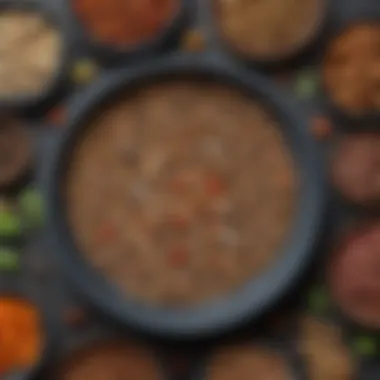
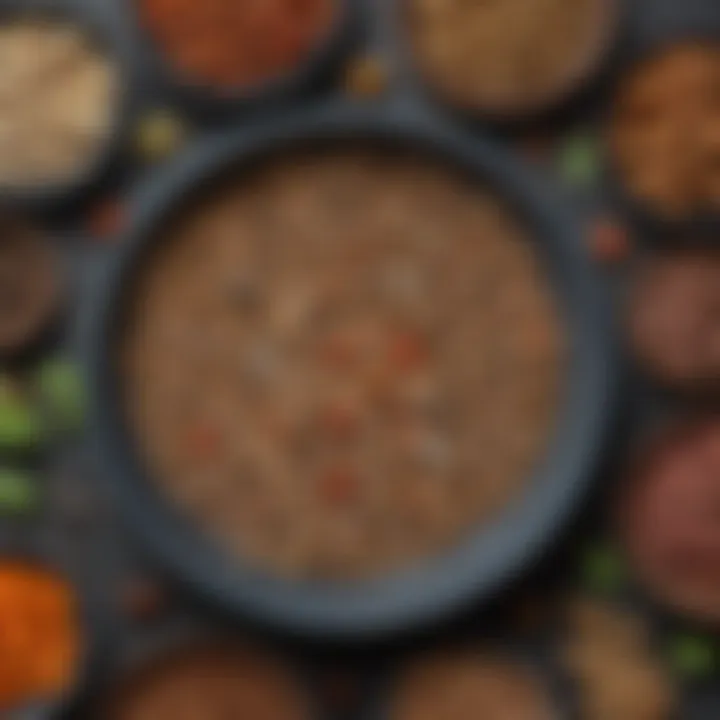
Intro
Small birds, with their vibrant colors and lively personalities, inspire affection among pet owners and enthusiasts alike. One crucial aspect of ensuring these birds thrive is their feeding environment. The choice of food dishes is not merely a matter of preference, but a vital component for the health and wellbeing of these creatures. This exploration looks closely at different types of small bird food dishes, their design elements, required materials, and the importance of hygiene practices. By understanding these factors, pet owners can significantly enhance their birds' quality of life.
Understanding Your Pet
Pet Behavior Basics
Birds exhibit fascinating behaviors that can help owners better understand their needs. Knowing what they prefer in terms of feeding can reduce stress for both the birds and their caretakers. For instance, small birds often feel safer when they eat in a confined area. Thus, reflecting this preference is important when selecting food dishes.
Common Breed Characteristics
Different breeds possess unique traits that influence their eating habits. For example, finches usually prefer shallow dishes, while cockatiels may require deeper options to accommodate their feeding style. Familiarity with these breed-specific traits aids in making informed choices about food dish selection.
Species-Specific Needs
Some species have dietary restrictions or preferences that dictate their feeding setup. Parrots, for example, benefit from varied food types which encourage exploration and foraging behavior. Dedicating attention to these specifics will support a happier and healthier bird.
Pet Care and Maintenance
Feeding Guidelines
Establishing a routine for feeding is essential for small birds. Regular feeding times keep birds accustomed to their schedule. Opting for small dishes allows for fresher food, reducing waste and promoting better dietary habits.
Grooming Essentials
While feeding dishes play a role in overall care, grooming also matters. Ensuring food dishes remain clean is equally important for maintaining overall health. Birds are sensitive to bacterial growth, which can lead to illness if not addressed.
Hygiene Practices
Hygiene is non-negotiable in pet care. Clean food dishes daily, removing any leftover food, and giving the dishes a thorough wash every few days. Using suitable biodegradable cleaning agents helps maintain a healthy environment for birds.
Training and Development
Basic Commands and Skills
Although training is not directly related to food dishes, positive reinforcement while interacting with food can make a difference. Birds that learn to respond to commands may receive treats from these dishes, enhancing their bond with owners.
Behavioral Training Techniques
Food can also serve as an effective tool for addressing behavioral issues. Reinforcing good behavior with treats from their food dishes encourages birds to repeat those actions.
Addressing Common Behavior Issues
Understanding their feeding habits can help mitigate behavior problems. For instance, birds that are anxious may over-eat or refuse food altogether. A suitable dish setup can promote a more relaxed dining environment.
Health and Wellness
Routine Vet Check-ups
Routine veterinary visits ensure that birds are healthy and thriving. Any potential dietary needs or concerns can be addressed during these appointments, offering further insights into food dish requirements.
Vaccination Needs
Certain vaccines help prevent health issues in small birds. Knowing what vaccinations are necessary will contribute to better overall health, impacting their dietary needs as well.
Recognizing Signs of Illness
Being able to recognize signs of illness is crucial. Birds may change their eating patterns or become less interested in food if they are unwell. Observing these shifts can alert owners to potential health issues.
Enrichment and Activities
Indoor vs.
Outdoor Activities Engaging small birds in both indoor and outdoor settings can improve their overall happiness. Different feeding environments can stimulate their natural foraging instincts, making the choice of food dishes even more significant.
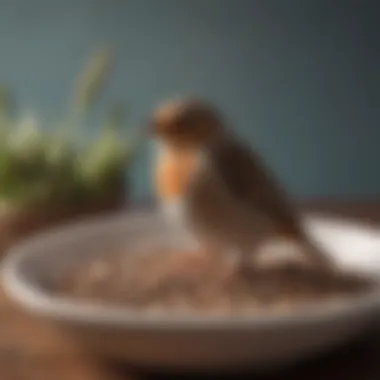
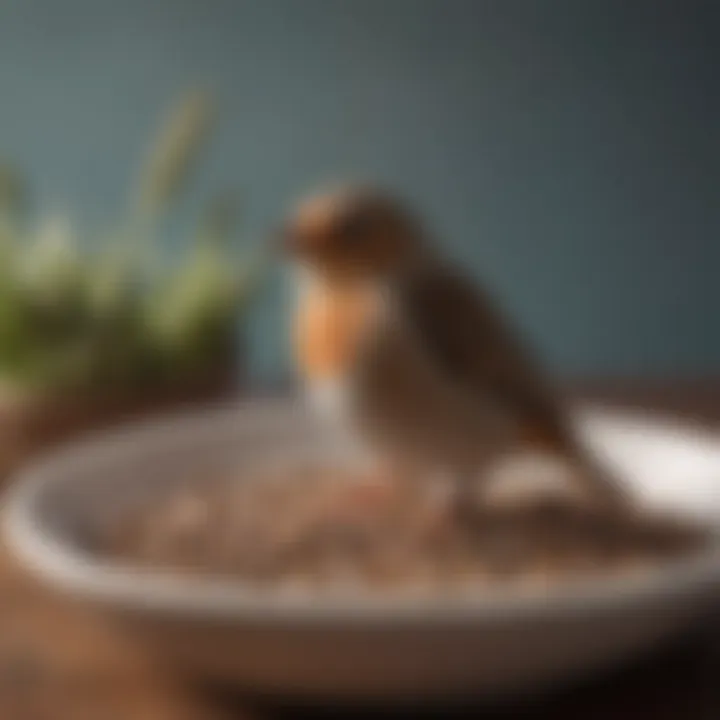
Interactive Toys and Games
Incorporating interactive toys and puzzles with food can provide mental stimulation. This encourages birds to work for their food, promoting natural foraging behavior and improving their wellbeing.
Socialization Opportunities
Social interactions can greatly benefit small birds. Feeding time can double as bonding time, where owners can interact closely with their pets, further fostering a strong relationship.
Understanding the nuances of small bird food dishes can profoundly affect their health and happiness. The proper selection and maintenance of these vital components create a pathway towards a better life for these cherished companions.
Preamble to Small Bird Food Dishes
Small birds are delightful companions. Their sight and sound enrich our lives. However, proper care is crucial for their health and longevity. One important aspect of this care is feeding. The choice and quality of food dishes play a significant role in their nutrition. In this section, we will explore why understanding small bird food dishes matters.
Importance of Proper Feeding
Providing proper feeding for small birds is essential for several reasons. First, a well-balanced diet supports their growth and strength. Unlike larger birds, small species require specific nutrients in precise amounts. Hence, the way we present food can influence their eating habits. For instance, if food is easy to access, birds may eat more comfortably. This can lead to better nourishment.
Furthermore, feeding habits have behavioral aspects. Small birds can be shy. A food dish that's too high or complex may discourage them from eating. Educated choices in feeding setups promote more positive behaviors. Healthy feeding can also lead to vibrant plumage and energy, contributing to an overall good quality of life.
Purpose of Food Dishes
Food dishes serve several purposes, each fundamental to small bird care. Primarily, they provide a designated space for they’re meals. This helps establish routine feeding times, which can be comforting for birds. Organization of eating areas reduces territorial disputes among multiple birds. It ensures that each bird has access to food triat, fostering a peaceful environment.
Moreover, the right dishes can help prevent food waste. With the correct depth and size, food remains visible and accessible. Birds are more likely to return to a dish they find familiar and easy to use.
In essence, the choice of food dishes impacts feeding behavior, nutrient intake, and overall bird health. As caretakers, it is our responsibility to ensure that our birds have access to the best feeding solutions. This encourages healthy habits and contributes to their wellbeing.
Types of Small Bird Food Dishes
Understanding the types of small bird food dishes is essential for anyone looking to care for these pets effectively. The selection of a food dish can directly influence a bird's feeding habits and overall health. Different birds have different requirements when it comes to food presentation. Utilizing the right dish can encourage eating and prevent waste.
Seed Dishes
Seed dishes are a common choice among bird owners. They are specifically designed to hold various types of seeds, which are a staple in many small birds' diets. The open design allows birds to easily access their food. A well-designed seed dish can also minimize spillage, which is beneficial for both cleanliness and cost-effectiveness. Some important factors to consider with seed dishes include:
- Material: Durable materials like ceramic and metal help prevent breakage. Plastic can be used, but it should be of high quality to avoid easy wear.
- Size: The dish should be appropriately sized to hold enough seed for the bird without causing overcrowding. Too small, and the bird won't have enough to eat. Too large, and the dish may be cumbersome.
- Design: Some seed dishes come with features like raised edges to keep seeds contained. Opting for a dish that is easy to clean can also enhance the feeding experience.
Pellet Dishes
Pellet dishes are specially designed to hold formulated diets in pellet form. Unlike seed dishes, they focus on providing balanced nutrition that many small bird species require.
Choosing the right pellet dish is crucial. Consider the following:
- Capacity: Ensure that the dish can hold enough pellets for daily feeding. However, avoid overfilling to prevent shelf life concerns for the pellets.
- Accessibility: The dish should be shallow enough for birds to reach the pellets easily but deep enough to prevent them from spilling out while feeding.
- Hygiene: Regular cleaning is vital, as leftover pellets can attract pests and bacteria. Opt for a dish that can be thoroughly cleaned without difficulty.
Water Dishes vs.
Food Dishes
Water dishes are distinct but often considered alongside food dishes. They serve the critical role of providing hydration to small birds. When comparing water dishes to food dishes:
- Design Differences: Water dishes usually need more depth than food dishes, allowing for swimming or bathing, which some birds enjoy. However, the dish should be shallow enough to allow for easy access without risk of drowning.
- Placement: Positioning both dishes in a stable manner is essential. Water dishes should be placed in an area less accessible to eliminate spillage.
- Quality: Just like food dishes, water dishes should be made of safe materials that are easy to clean to maintain hygiene.
In summary, understanding the types of small bird food dishes greatly aids in making informed choices that can positively affect a bird’s health. Proper selection leads to better feeding practices, ultimately enhancing the bird's life quality.
Design Considerations
When it comes to selecting food dishes for small birds, understanding design considerations is crucial. The design of these dishes can significantly impact their usability, hygiene, and the birds' overall eating experience. From size to material choices, every aspect plays a role in ensuring the birds can feed comfortably and safely.
Size and Depth of Dishes
The size and depth of the dish are fundamental considerations. A dish that is too small may limit the availability of food, forcing the bird to compete for space. Conversely, a dish that is too large could lead to waste, as birds might not be able to reach food that is spread too far apart.
The depth of the dish also matters. Shallow dishes allow small birds to access their food easily, while deeper designs might restrict their ability to see and reach all the contents. Therefore, finding the right balance in size and depth is essential for optimal feeding.
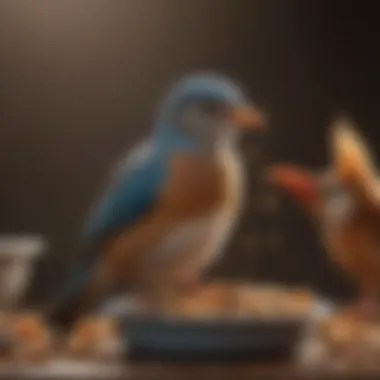
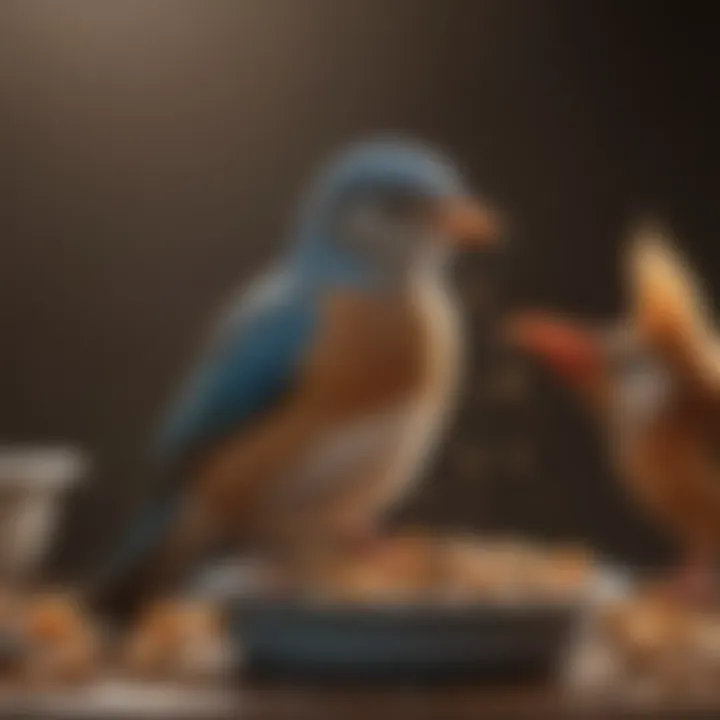
Material Choices
Plastic
Plastic is a common material for small bird food dishes, primarily due to its lightweight nature and variety of shapes. It is easy to clean and often comes in bright colors that might attract birds. However, plastic can pose certain risks. Over time, it may scratch, creating grooves that harbor bacteria. Pet owners must regularly inspect plastic dishes and replace them if significant wear is present.
Ceramic
Ceramic dishes offer a sturdy and stable option, reducing the risk of tipping over during feeding. They often have a visually appealing finish, which makes them a popular choice among bird owners. One key advantage of ceramic is that it is less likely to harbor bacteria compared to plastic. However, the weight of ceramic dishes is a consideration; they can be cumbersome for very active birds or those that rely on mobility. Additionally, if dropped, ceramic dishes may shatter.
Metal
Metal food dishes, often made from stainless steel, provide durability and resistance to chewing. They are easy to clean and do not absorb odors or colors, which keeps the dishes sanitary. Moreover, metal can be more resistant to weather conditions if used outside. However, some birds may find metal surfaces unfamiliar, which could deter them from using the dish. Understanding the preferences of your specific bird species can help in deciding if a metal dish is suitable.
Accessibility and Placement
The accessibility and proper placement of food dishes are essential for small birds. Dishes should be positioned at a height that allows easy access without causing stress. If the dish is too high or awkwardly placed, birds may struggle to reach their food, leading to frustration or reluctance to eat.
Additionally, maintaining a clean environment around the dish is vital. Any leftover food can attract pests and lead to contamination, which can endanger the health of your birds. Ensuring that dishes are easy to access for regular cleaning will promote better hygiene and a healthier feeding routine.
Overall, taking the time to evaluate these design considerations ensures that bird owners can make informed choices that enhance the wellbeing and happiness of their feathered companions.
Selecting the Right Dish for Your Bird
Choosing the correct food dish is one of the most crucial decisions for the health and happiness of your small bird. The right dish not only influences how feeding is perceived by the bird, but also affects its overall nutrition and well-being. By understanding the preferences unique to different species, as well as considering specific needs, you can provide a feeding environment that maximizes your bird's appetite and enjoyment.
Understanding Bird Preferences
Birds have particular preferences that can significantly shape their eating habits. Understanding these preferences is essential for selecting the right food dish. For instance, some birds prefer shallow dishes, while others might thrive with deeper bowls. Small species, like finches, often favor a more stable dish to prevent tipping. Other factors to consider include color and material, as certain birds may feel more attracted to specific hues or textures.
Key Points About Preferences:
- Depth and Size: Shallower dishes are generally more appealing for smaller birds.
- Material: Birds may have a preference for either ceramic or metal, impacting their willingness to use the dish.
- Visibility: Transparent dishes may be suitable for shy birds who want to feel secure while eating.
Understanding these factors allows bird owners to create an optimal feeding experience that caters to their bird's instincts and comfort level.
Consideration of Species-Specific Needs
Each bird species has its own dietary habits and preferences that necessitate tailored feeding solutions. For example, parrots typically require a larger, more durable dish to hold the diverse range of foods they enjoy, such as fruits, vegetables, and pellets. In contrast, smaller species like canaries might do well with a petite dish that suits their nibbling style.
Species-Specific Considerations:
- Diet Variety: Some birds require versatility in their food dishes to accommodate mixed diets.
- Feeding Behavior: Many small birds prefer to forage, so dishes that encourage this behavior can be beneficial.
- Social Interaction: Some species thrive on social feeding, necessitating multiple dishes or communal setups.
By recognizing these individual needs, bird owners can select dishes that align with natural behaviors, promoting healthier eating patterns.
Understanding your bird's specific needs builds a bridge between their dietary health and their overall happiness.
Hygiene and Maintenance
Maintaining cleanliness in small bird food dishes is not just a routine task; it is essential for the well-being of your avian companions. Proper hygiene ensures that small birds remain healthy and free from diseases. Without consistent care and thorough cleaning, food dishes can become a breeding ground for bacteria and mold, affecting the birds' health. Regular hygiene practices keep food safe and prevent cross-contamination between different food types.
Importance of Regular Cleaning
Regular cleaning of food dishes is crucial for several reasons. First, it helps eliminate harmful bacteria and fungi that can thrive on leftover food particles. These microorganisms may cause gastrointestinal issues and other health problems in birds. Additionally, dirty food dishes can attract pests, which may further endanger your bird's safety.
Moreover, keeping the dishes clean encourages birds to eat. Birds are more likely to consume food from a fresh and clean container. They are instinctively cautious about their environment, and dirty dishes may deter them from eating or lead them to avoid certain food types altogether.
Here are some benefits of regular cleaning:
- Reduces the risk of infections.
- Promotes better eating habits.
- Enhances overall bird health and longevity.
Best Practices for Dish Care
Caring for small bird food dishes involves a few simple yet effective practices. Here are some tips to ensure your bird's dishes are always in the best condition:
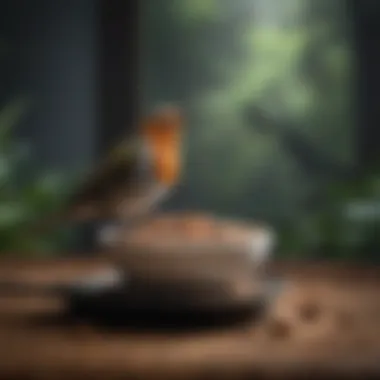
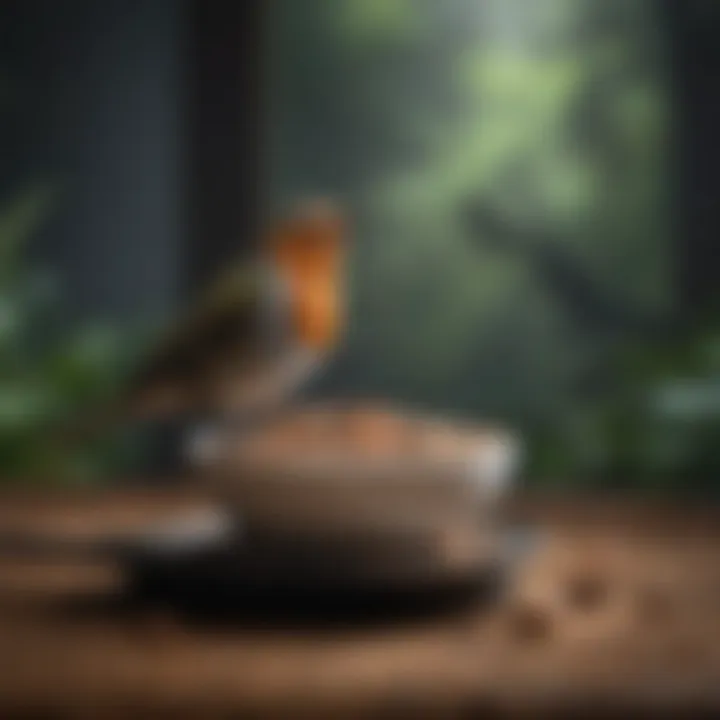
- Daily Inspection: Check food dishes every day for any signs of spoilage or contamination. Remove any uneaten food promptly to avoid decay.
- Wash Thoroughly: Use hot, soapy water to wash dishes at least once a week, or more frequently if they show signs of buildup. Rinse them well to ensure no soap residue remains.
- Use Safe Products: Avoid harsh chemicals that could harm birds. Opt for bird-safe cleaning products or natural solutions such as vinegar or baking soda.
- Dry Completely: Ensure dishes are fully dry before refilling them with food. Moisture can lead to mold growth.
- Rotate Dishes: Have multiple dishes on hand so you can rotate them during cleaning. This ensures your bird has access to fresh food while one dish is being cleaned.
Keeping food dishes clean is one of the simplest ways to promote the health of your small bird. Regular hygiene practices play a significant role in ensuring a safe and healthy feeding environment.
By adhering to these cleaning practices, you can help maintain not only the hygiene of the food dishes but also the general health of your beloved small birds.
Feeding Tips for Small Birds
Feeding small birds is a critical aspect of ensuring their health and well-being. A well-planned feeding routine not only supports their nutritional needs but also enhances their overall quality of life. Proper feeding tips contribute to maintaining a healthy weight, encouraging natural behaviors, and preventing the occurrence of behavioral issues. Thus, understanding effective feeding strategies becomes paramount for bird owners.
Portion Sizes and Frequency
Establishing the right portion sizes and feeding frequency is vital in avian care. Birds can easily overeat or become undernourished if allowed access to food without a schedule. It is essential to consider the size, species, and age of the bird when determining portions.
- General Guidelines: Many small birds benefit from being fed small amounts multiple times a day. For example, smaller species like finches may need one or two teaspoons of food per feeding session. In contrast, larger species may require more substantial portions.
- Avoid Free Feeding: Free feeding, or leaving food available at all times, can lead to obesity. Birds may eat more out of boredom or stress rather than true hunger.
- Adjust Portions: Pay attention to your bird's eating habits. Adjust portions based on activity level and health status. Finally, regular weighing can help monitor any weight changes over time.
It is crucial to observe your bird and adapt to its needs.
Combining Different Food Types
Combining food types provides a balanced diet catered to the specific needs of small birds. Many species thrive on a combination of seeds, pellets, and fresh foods, ensuring they get necessary nutrients.
- Seeds and Pellets: Mixing seed blends with pellets can encourage better nutrition. Pellets provide essential vitamins and minerals that seeds may lack.
- Fresh Foods: Incorporate fresh fruits and vegetables into the diet. This adds natural moisture and additional nutrients. However, not all birds will enjoy the same fresh items, so it is essential to experiment and see what preferences emerge.
- Monitor Reactions: Always introduce new foods gradually. Monitor for any signs of distress or digestive issues. Adjust the mix of food types based on the bird's response and behavior.
By adhering to these feeding tips, bird owners can contribute to a better nutritional foundation for their pets, ensuring a happy and healthy existence.
Potential Issues with Food Dishes
Food dishes for small birds serve a critical role in their nutrition and overall health. However, they are not without potential challenges and risks. Understanding these issues is crucial for any bird keeper, as they can significantly impact the well-being of these charming creatures. This section highlights potential issues related to food dishes, focusing on contamination concerns and behavioral issues that may arise due to design inadequacies.
Contamination Concerns
One major issue with food dishes is the risk of contamination. Food can easily become spoiled or tainted when not properly managed. Contaminated food can lead to severe health issues for birds, like gastrointestinal diseases, infections or even fatalities. It is important to be vigilant about what is offered in these dishes. Spoiled seeds, pellets, or fresh food must be removed promptly.
Here are some common contamination sources to keep in mind:
- Bacteria and Mold: Leftover food sitting in dishes may cultivate harmful bacteria or mold, which can be toxic to birds.
- Dirty Dishes: Regularly cleaning the food dish is essential. Old residue can fester germs that endanger a bird’s health.
- Environmental Factors: Dust, dirt, and pet dander can settle in food dishes, causing further contamination.
To minimize contamination risks, ensure to:
- Clean dishes regularly with bird-safe disinfectants.
- Replace food daily, especially perishable items.
- Check the dishes for any signs of wear that may harbor bacteria.
Regular inspection and maintenance of food dishes is vital for maintaining a healthy feeding environment.
Behavioral Issues Related to Dish Design
The design of food dishes can influence bird behavior significantly. If a food dish is not designed properly, it could lead to stress or anxiety for the bird. Dish design affects access to food, which in turn affects the bird's feeding habits. Small birds may become frustrated if they cannot reach their food easily or feel insecure while eating.
Consider these aspects of dish design that can lead to behavioral issues:
- Size and Shape: Dishes that are too deep or narrow may make it hard for birds to access food, leading to frustration.
- Location: If a food dish is too exposed, birds may feel threatened and avoid feeding, affecting their health.
- Material and Texture: Birds have preferences for certain materials; a rough texture or distracting colors may deter them from using the dish.
To foster a better feeding experience, try:
- Observing bird behavior to gauge preferences for dish style.
- Using dishes with barriers that allow for comfort while feeding.
- Ensuring stable placement to avoid spills and food waste.
By addressing these potential issues, owners can create a safer and more enjoyable eating environment for their small birds.
The End
The conclusion of this article emphasizes the critical role that small bird food dishes play in avian health and welfare. Selecting appropriate food dishes is not merely an aesthetic choice; it directly influences a bird's nutrition, comfort, and overall well-being. Factors such as dish size, material, and cleanliness stand at the forefront of effective bird care. Through careful consideration of these elements, pet owners can create an environment that promotes healthy eating habits and enhances the quality of life for their feathered companions.
Summary of Key Points
In this narrative, several key points regarding small bird food dishes have been highlighted:
- Proper feeding is essential for maintaining avian health and preventing dietary-related issues.
- Different types of food dishes, such as seed and pellet dishes, serve specific nutritional needs.
- Material selection greatly impacts hygiene and durability; materials like plastic, ceramic, and metal each offer unique advantages.
- Accessibility and placement of dishes are crucial. Birds need easy access to their food while feeling safe.
- Regular hygiene and maintenance are vital for preventing contamination, a common issue in avian feeding.
- Awareness of behavioral patterns can guide dish design; certain shapes and formats may suit different bird species better.
Encouragement for Informed Choices
As a pet owner or bird enthusiast, making informed choices about food dishes is paramount. Awareness of your bird's unique needs will foster a healthier diet and improve their living conditions. -> By regularly assessing dish conditions, cleaning routines, and selecting the right type of food dishes, you can significantly influence your bird's health. This responsibility requires commitment but brings immense rewards in the form of a happy, healthy companion.
For further insights and avian care tips, you might consider exploring resources like Wikipedia and Britannica. Engaging with other bird enthusiasts on platforms like Reddit and Facebook can also enhance your knowledge and support your journey in pet care.







